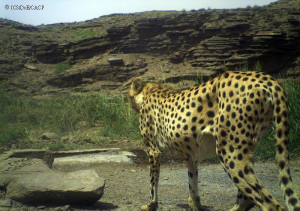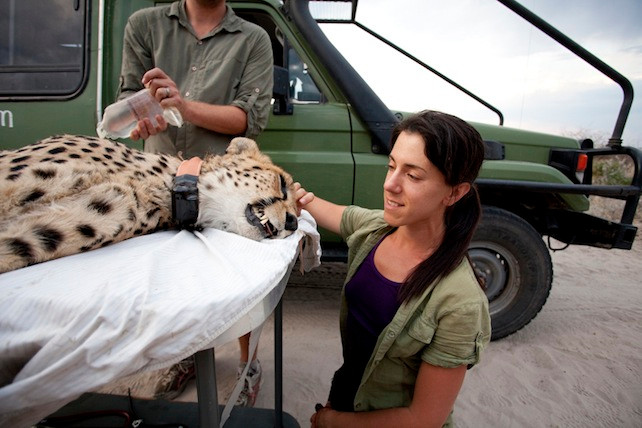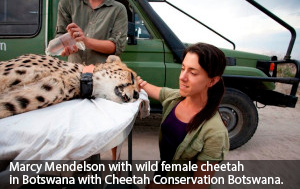The first time Marcy Mendelson saw a cheetah was on television during a National Geographic nature special. She was four years old. Now she’s a conservation photographer who snaps for National Geographic, preparing to lead an epic Altruvistas journey to Iran, the very first eco-tour in the name of the Asiatic Cheetah.
Wait a minute. Hold the phone.
There’s an Iranian cheetah?! That’s affirmative, and Altruvistas has the trip to prove it.
On April 18, 2015, Mendelson and Cheetah-Watch will guide travelers on a magical Cheetah Conservation and World Heritage journey into Iran to explore this enigmatic, endangered cat’s world and experience the beauty of Iran, its people and wildlife.
The Asiatic Cheetah is one of the rarest cats on the planet. There is evidence of the Asiatic Cheetah as a part of Iranian society dating back hundreds, if not thousands of years. Today, their struggle is one of habitat and prey loss, in addition to being viewed as a pest animal that threatens local livestock. But with the outreach of the Iranian Cheetah Society, along with tours such as this one that brings an eco-tourism model to the region, change is possible.
Mendelson is the perfect person to guide this trip, between her passion for cheetahs and her on-the-ground experience. As the Cheetah-Watch website reveals, she has traveled to remaining cheetah strongholds in Kenya, Namibia, Botswana & South Africa to expose the human-wildlife conflict through contrasting visual profiles of rural communities protecting their livelihoods and the conservationist whose mission it is to preserve and protect the last of the cheetah populations.
The Iranian cheetah is in a fight for survival like never before, and trip participants will learn from experts from the Iranian Cheetah Society and meet with Iranians passionate about the cheetah’s legacy and the conservation of Iran’s environment. They’ll also visit national parks, cultural centers like Yazd, Isfahan and Shiraz, and explore important UNESCO World Heritage Sites like Persepolis and Pasargad.
What first attracted Mendelson to the Asiatic Cheetah? She explains:
Cheetahs captured my imagination from childhood. Their lithe form, speed and grace are a thing of beauty and power. As for the Asiatic Cheetah, I was unaware of their existence until diving into the conservation world in 2010. It breaks my heart to know few people in the world are aware of their existence and their low numbers are distressing. Hunted to extinction in India in the 1940s and long gone from Saudi Arabia and surrounding countries, their remaining stronghold is in Iran. I feel passionate about supporting conservation efforts of the Iranian Cheetah Society as they work toward the Asiatic Cheetah’s survival and rebound.
Describing the upcoming journey, Mendelson says, “The conservation and ecology talks on our tour from the Iranian Cheetah Society representatives and park rangers are not something your average tourist will have the opportunity to access. Guests will return with a passion for the landscape, animals and lifestyles of the Iranian people and its deep ecological heritage. I have a feeling our guests will be talking about Iran for a long time to come!”
The first time Mendelson saw a wild cheetah was on safari in Botswana. As she tells it:
Hundreds of animals were running as fast as their legs could take them, all in the same direction. It meant only one thing; a predator had initiated a hunt. Our driver swung left. After 20 minutes of searching he spotted a large male cheetah panting as he walked through the dry bush. His breathing was rapid as he had just made an unsuccessful dash at his legendary top speed. We watched as he threw himself down under a tree to regroup for another try later in the evening.
You can read more about this experience and see photos on Mendelson’s blog.
So what are the chances of seeing an Asiatic Cheetah in the wild during this trip?
The honest answer? With their population numbers down around 70-100 known, the chances are a bit slim, but the possibility is there, and in Touran, participants will definitely get to meet a rescued wild cheetah.
Travelers may see other species in the wild as well, since Iran is abundant in wildlife, including the Ibex Antelope, Fallow Deer, and the Sand Cat.
Fancy an eco-trip to Iran to explore the Asiatic Cheetah conservation for yourself?
Iran is making a concerted effort to reach out to Western travelers, and in the last year many published articles have come out lauding Iran as a top global travel destination, including the Los Angeles Times, Guardian UK, Financial Times and others.
What makes the Cheetah Conservation and World Heritage journey into Iran special, as Mendelson puts it, is that “It’s the very first Eco-Tour in the name of the Asiatic Cheetah, a truly unique and rare experience in a part of the world most have only dreamed of visiting!”
For info about the trip and how you can join the adventure, visit Altruvistas.com.

Photo courtesy of the Iranian Cheetah Society
How to Help Cheetahs
What can everyday people do to help diminishing wild cheetahs and other populations of animals threatened with extinction?
Mendelson advises:
Donate money and talk to their friends about the issues. Conservation organizations operate on a shoe-string budget. I’ve seen this with my own eyes. They need vehicles, they need to hire park rangers and they need operational costs covered in addition to helping the animals they rescue and care for.
2 Recommended Organizations that Help Cheetahs:
Here’s a link to some other Cheetah conservation organizations.







